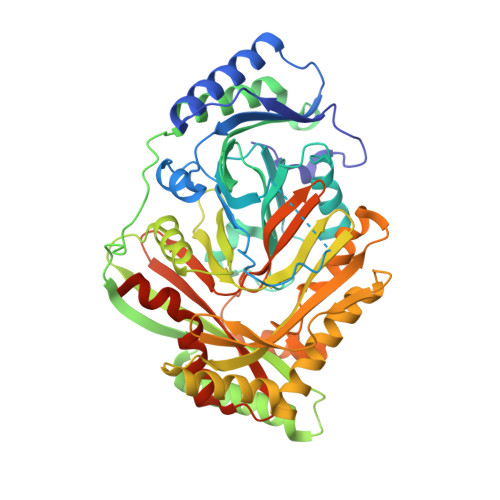Structural basis of chorismate isomerization by Arabidopsis ISOCHORISMATE SYNTHASE1.
Su, Z., Niu, C., Zhou, S., Xu, G., Zhu, P., Fu, Q., Zhang, Y., Ming, Z.(2024) Plant Physiol 196: 773-787
- PubMed: 38701037
- DOI: https://doi.org/10.1093/plphys/kiae260
- Primary Citation of Related Structures:
8W6V, 8W71 - PubMed Abstract:
Salicylic acid (SA) plays a crucial role in plant defense against biotrophic and semi-biotrophic pathogens. In Arabidopsis (Arabidopsis thaliana), isochorismate synthase 1 (AtICS1) is a key enzyme for the pathogen-induced biosynthesis of SA via catalytic conversion of chorismate into isochorismate, an essential precursor for SA synthesis. Despite the extensive knowledge of ICS1-related menaquinone, siderophore, tryptophan (MST) enzymes in bacteria, the structural mechanisms for substrate binding and catalysis in plant isochorismate synthase (ICS) enzymes are unknown. This study reveals that plant ICS enzymes catalyze the isomerization of chorismate through a magnesium-dependent mechanism, with AtICS1 exhibiting the most substantial catalytic activity. Additionally, we present high-resolution crystal structures of apo AtICS1 and its complex with chorismate, offering detailed insights into the mechanisms of substrate recognition and catalysis. Importantly, our investigation indicates the existence of a potential substrate entrance channel and a gating mechanism regulating substrate into the catalytic site. Structural comparisons of AtICS1 with MST enzymes suggest a shared structural framework with conserved gating and catalytic mechanisms. This work provides valuable insights into the structural and regulatory mechanisms governing substrate delivery and catalysis in AtICS1, as well as other plant ICS enzymes.
- State Key Laboratory for Conservation and Utilization of Subtropical Agro-bioresources, College of Life Science and Technology, Guangxi Key Laboratory for Sugarcane Biology, Guangxi University, Nanning 530004, P. R. China.
Organizational Affiliation:



















